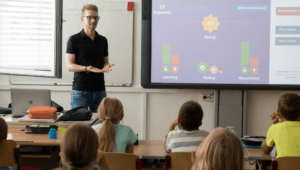Part 1: 44 Smart Ways to Use Smartphones in Class

This week an online article grabbed my attention. Its title read “94 Percent of High School Students Using Cellphones in Class.” I immediately scoped out the heading and thought to myself, “Finally, teachers are beginning to embrace the powerful little gadgets.” However, it did not take me long to realize the researched article took quite a different slant.
One quotation in particular caused serious professional introspection on my behalf. The article quotes the researchers as stating, “‘The potential damage stemming from heightened cell phone use during class casts a pall on the entire educational system, on the school atmosphere, on the educational achievements of the class, on the pupil’s own learning experience and on the teacher’s burnout having to cope with discipline problems in class.’”
I understand the tougher task of using regular cell phones in class versus internet ready smartphones, however , I could not disagree more with the above quotation. Although there is no doubt the very same scenarios mentioned in the above article are occurring in various classrooms around the globe, I now encourage all students to bring their cellphones or smartphones to class. Just a few years prior, my colleagues and I were struggling mightily with how to integrate the crafty handheld tools.
A blessed trip to the ISTE 2011 conference in Philadelphia helped me devise a BYOD classroom management plan and opened my eyes to the infinite educational potential of smartphones in the classroom.
However, one of my toughest baseball coaches once said, “Potential and a dollar will get you a Coke.” With this in mind, a simple, but effective, “Traffic Light” BYOD classroom management plan was born. Check out this post to read more about it.
I believe the potential of smartphones, supported by a strong classroom management system, can be summed up with what I call “The Five C’s.” Collaborate, communicate, create and coordinate/curate. Of the forty-four ideas below regarding smartphones, twelve can be accomplished with a simple cellphone. Take a look below at this enormous potential.
Use Smartphones to Collaborate
- Have students peer-assess their classmates’ essays through a Google Form embedded on teacher page, and allow them to view real-time constructive criticism. Afterwards, polish up the spreadsheet and share with students. Believe me, they will be interested. Click here to see how successful this strategy can be.
- Allow texting in class to peer-edit and offer constructive criticism for writing projects. Just imagine students sharing thesis statements and introductory paragraphs without ever saying a word. This is just one of the strategies we use to create a quiet and successful writing atmosphere in Studio 113. Check it out here.
- Make brainstorming visible via a projected image with Polleverywhere.com and Wallwisher.com. Using these two sites really is too simple. Although Wallwisher requires an internet connection, students may use a cellphone for Polleverywhere.com.
- Create a shared list of notes by making a Google Form available. I usually embed Google Forms on my teacher page for easy access. Afterwards, I make the spreadsheet of notes available to all students.
- Have students post relative links of videos, websites, etc. for a unit of study. I like to think of this as the Army of Talent completing a task in a fraction of the time it would take one teacher hours to finish. This strategy is highly effective as it invites students to co-create their learning environment and unit. A Google Form would easily serve this purpose.
- Make thoughts visible by having students post videos and text or by having them phone in their answers to Voicethread. Check out our recent Voicethread here.
- Engage readers in real-time as they work through the assigned reading by collaborating with their peers via a Twitter hashtag, Polleverywhere.com, Todaysmeet.com, or Wallwisher.com.
- Have students call in-class peers during an interactive learning structure. Click here to see a cool idea.
Use Smartphones to Communicate
- Use FaceTime on the iPhone to add outside audience members during class discussion or learning activity. This is perhaps one of the coolest things we have recently done in class.
- Allow students to read from their smartphones during SSR (Silent Sustained Reading) while sharing interesting articles via Polleverywhere.com.
- Allow students to video or audio record your assignment instructions.
- View student exemplary products from school YouTube channel.
- Augment lessons with excellent videos from Ted.com or RSA.
- Use a Twitter hashtag to augment the in-class lesson or extend the conversation after class. Click here to read about a tri-state conversation about a Presidential debate.
- Establish a Twitter class account to share class assignments and reminders. If students do not want a Twitter account, make it easy. Embed the Twitter feed on your teacher page.
- Send students reminders in-class/after-class through ClassParrot and Remind 101.
- Have a silent discussion via Todaysmeet.com.
- Capture learning moments. Ever had a student raise a hand, make a connection, and say, “Have you seen the video that….?” Ask students to e-mail pertinent links during class and show the video in minutes.
- Have students assess the teacher through a Google Form.
- Use Google Translate to break down language barriers.
- Use Instagram or Twitter to advertise class projects.
Use Smartphones to Create
- Write with apps such as My Writing Spot and Evernote.
- Set up a portable writing station by connecting a keyboard to smartphone via Bluetooth.
- Use dictionary and thesaurus apps.
- Use Dragon Dictation for struggling writers. Interested? Click here.
- Write on-the-go during a field trip or active lesson on campus with Tripline.
- Create “How-To” guides using apps such as SnapGuide.
- Write to Blog Post via the Blogger app.
- Peruse playlists while double-checking the lyrics on the internet to create a soundtrack that applies to current studies.
- Create Twitter parodies of certain characters, historical figures, chemical equations, geometry theorems, and animals of study in Biology class.
- Create a mini-presentation, skit, or formal response to a prompt and e-mail the video to teacher’s Posterous blog spot.
Use Smartphones to Coordinate/Curate
- Relax and write with apps like Nature Music or iZen Garden.
- Listen to music as source of inspiration for creative projects.
- Have students access their peers’ blogs by sharing a Symbaloo webmix on teacher page. Check out this one.
- Point students in the right direction for creative tech tools.
- Save time and paper by accessing documents on teacher’s website.
- Share spreadsheets of notes with Google Drive.
- Get to know your students by having them complete a Google Form.
- Research key sites to bolster students’ projects.
- Manage students’ knowledge of current lessons by having them take a quiz directly from their smartphones via Socrative.
- Allow students to check their grades via on-line gradebook or learning platform.
- Have students question peers outside class and send their recorded opinions to Voicethread or Posterous.
- Use apps like Reminders and PocketLife Calendar to plan study times and project times. The Weather Channel app is handy for avoiding weather conflicts during outside project time.
- Use the calculator app to calculate scores during gamified learning structures.
- Use the stopwatch and timer apps to manage class time.
I hope these ideas help others appropriately manage and integrate cellphones and smartphones in the classroom learning environment. When used properly, smartphones act as handheld computers, not just overly priced texting gadgets. Please check back in two weeks for Part 2 of “Smart Ways to Use Smartphones in Class.” At this time, I will discuss using smartphones for videos, pictures and more. In the meantime, please share your thoughts below.





There is software called display note that allows you to colloborate with ALL the smart devices in your class (both android and apple at the same time.) I can help you get a free trial if you want. I just saw your tweet and wanted to responed. http://www.
see demo video too: http://www.touchboards.com/DisplayNote/DisplayNote.html
Cindy
That would be an awesome way to link kids at home with a cold to the classroom.
Tim Slack
Great post! If we are not allowing students to BYOD we are really missing the boat. This is how students learn today and to deprive them of their main learning tools just does not make sense! You have listed so many great ideas! The possibilities are endless.
John Hardison
Cindy,
I totally agree. We have to think out of the box to tear down the classroom walls. Using technology to "bring" an at-home student into the classroom is the easier part. Developing challenging and engaging lesson plans that encourage at-home students to "attend"? Now that's the tough part at times. Thanks for your comments. Best wishes,
John
John Hardison
Thanks, Tim. You're absolutely right. What sense does it make to fight the proliferation of technology in the classroom when tech gadgets have so much educational value? Thanks again for commenting. Please share any ideas you may have. Blessings,
John
Laura Conley (@lconley86)
Great article. We use or have used several of the resources you've listed...all good! Thank you!
Rebecca
Not to be a naysayer, but how do you handle it when students use their device to be off-task? In a math class and they are tweeting about the baskeball game last night or playing Fun Run, how do you turn that into something of educational value? I see the benefits of using smartphones in their work but the reality is that smartphones are being used to NOT work. Any suggestions for this newbie in the classroom?
John Hardison
Rebecca,
Thank you for commenting on this post. I definitely understand your concern. In doing my best to provide a helpful response, I can only speak from the success and failures in our classes. The majority of our classroom success can be attributed to our foundational setup. Leaning heavily on the ideas found in Henry Wong's The First Days of School, the students and I spend the first few days completing a "Training Camp." This three-to-four day setup covers everything from course syllabus, student behavior, and, most importantly, classroom procedures. Mini-lessons that begin to cover the assigned standards and literature are embedded in training that introduces all students to classroom procedures, such as: 1. turning in assignments 2. working productively in teams 3. following the BYOD policy (a traffic light system: see link below) 4. participating in traditional classroom discussions (raising hands and proper respect when commenting/disagreeing) 5. understanding consequences for misbehavior (with/without the use of BYOD) and 6. following other minor details (labeling of papers or digital documents). After introducing each one of these procedures, the entire class practices each one individually to the levels of expectation discussed in the "Training Camp." Finally, after three days of training, the students complete a test that covers all notes taken and procedures practiced the first three-four days.
By no means does this training create a perfect class, but it does create an informed family of cooperative learners. Do I still deal with students who may use their mobile devices for non-class issues some times? Yes, but very minimally. In this case, I treat all violations of classroom BYOD policy as normal misconduct, and I follow the same disciplinarian procedures as I would for more traditional examples.
To me, everything has changed in the class, while nothing has changed. In example, students still "pass" notes, however, their forms of "passing" these notes have changed. If a situation occurs, the first questions I ask myself are, "Is my lesson plan engaging? Are the students' interests taken into consideration when developing units of study? Do the students have a voice in planning project-based learning assignments and activities?" Ultimately, I have seldom seen students be off-task during an engaging, creative, and oftentimes non-sedentary assignment. I constantly seek to create these types of lesson plans and projects. If smartphones, which I consider to be powerful mini-laptops and should therefore be called "palmtops," are necessary for completing a particular assignment, a green light from our BYOD traffic light is visible. At this time, I am constantly walking around the class and assisting with the assignment. When, for whatever educational reason, no technology is warranted, a red light indicates that all mobile devices should be put away and not used.
The positive, creative uses of smartphones and other mobile devices in the classroom far outweigh the negative possibilities. Just like I would never make all students quit writing just because Student A was passing a note to Student B in the back of the classroom, I will not have all students pocket such powerful learning devices for the duration of the class simply because one student lacks the discipline needed to follow and respect the guidelines of the learning environment.
Again, thanks for your thoughtful, honest comment. I wish you and your students boundless success in all your classroom endeavors.
Blessings,
John
The Traffic Light BYOD Management System in Studio 113: http://www.gettingsmart.com/gettingsmart-staging/cms/blog/2012/11/calling-all-resources-fostering-the-right-time-to-write/
Phillip
Cell phones can be of great use in schools if they are well integrated. They support mobile learning and individual learning. Though guidelines should be set to govern the usage of cell phones in classroom by students because some of them abuse them and use them to cheat exams
jbfrussell
wonderful article!
Im trying to think of new ways to use smartpones in the school. The use of QRs seems to be interesting.
Replies
John Hardison
Glad you found this article helpful. If you're interested in a cool activity integrating smartphones and QR codes, check out this article: http://www.gettingsmart.com/gettingsmart-staging/2013/02/soundcloud-qr-codes-a-gallery-of-students-voices/. Blessings...
Emma Daley
Thank you John for a wonderful article. It's amazing what can be truly achieved with creativity, imagination and thinking outside the traditional boundaries. Im referring to your fantastic article in my uni assignment and hope to bring you wonderful ideas to my classrooms in Australia ASAP!
Kim Thomas
Thanks so much for all this wonderful information. We are piloting BYOD in grades 3rd-8th and these resources are going to a wealth of information for the group.
Kim T.
Phoenix, AZ
muhammad asif
nice article
Okolie Anthony
I've always tried to make it clear to people and Lecturers that smartphones are of great help to college students. Thanks for sharing this information.
Caleigh
Hi! I am a student in the wonderful state of Virginia and I was wondering if there was any technology SPECIFICALLY designed for smartphones. We have been supplied with Chromebooks and most of these resources you have provided seem to be available on the these horrible laptops. The only one I found that seemed to best fit a cellular device is the Remind app. I use it and it functions wonderfully. But are there any apps that function the best on smart phones and add to the learning environment? Thank you for reading!.
Don Fischer
Wonderful article. There are expectations to use smartphones in rural areas. South Africa has done some policy work to implement UNESCO guidelines for mobile learning. Have you worked with smartphones where the students are geographically separated. How do you provide for them to submit separate assignments, particularly in math and science? What does the small screen size cause you to do?
Carlos Seoane
Extempore is a new app, just released, that enables foreign language teachers to move speaking practice activities from the classroom to their student's phones or tablets. We are based in St. Paul, MN, and we would love for you to try it and let us know what you think!
Smart Class
Thanks for Sharing .. i was wondering Is there any application for mapping Smart class Content !! hope somebody will reply?
Zulfiqar Anees
Students should make positive use of mobile phones. Using mobile phones for educational games and quizzes can help bring your class together.
Smartphones
Great article. We use or have used several of the resources you’ve listed…all good! Students should make positive use of mobile phones.